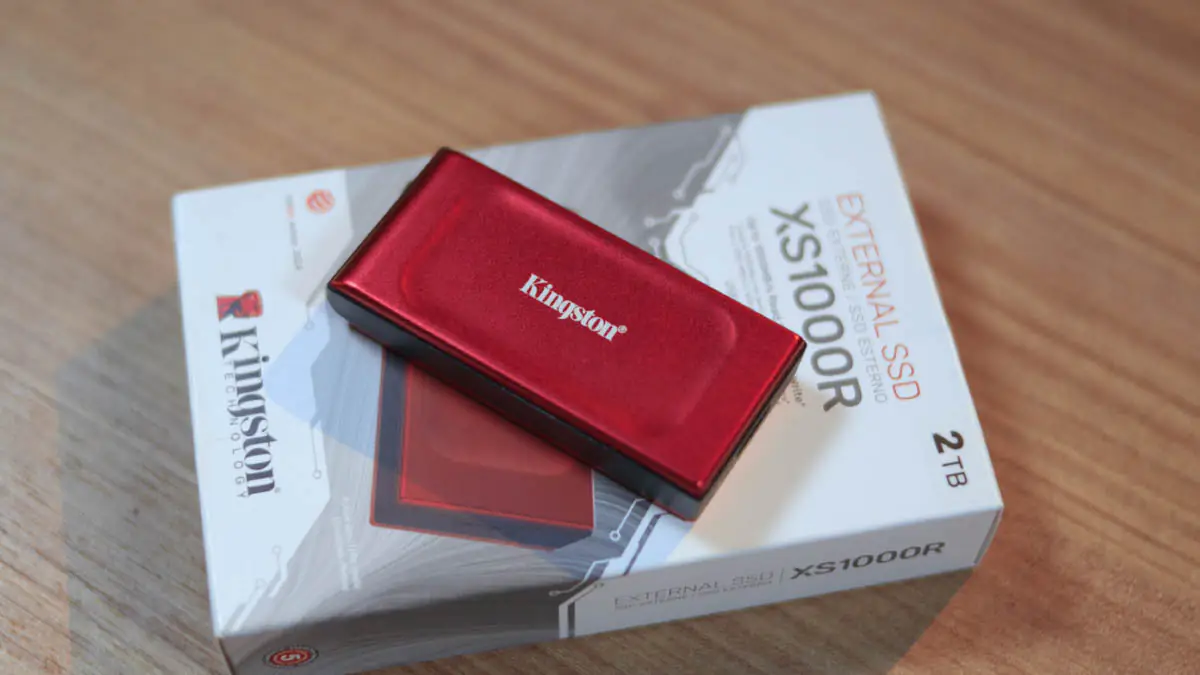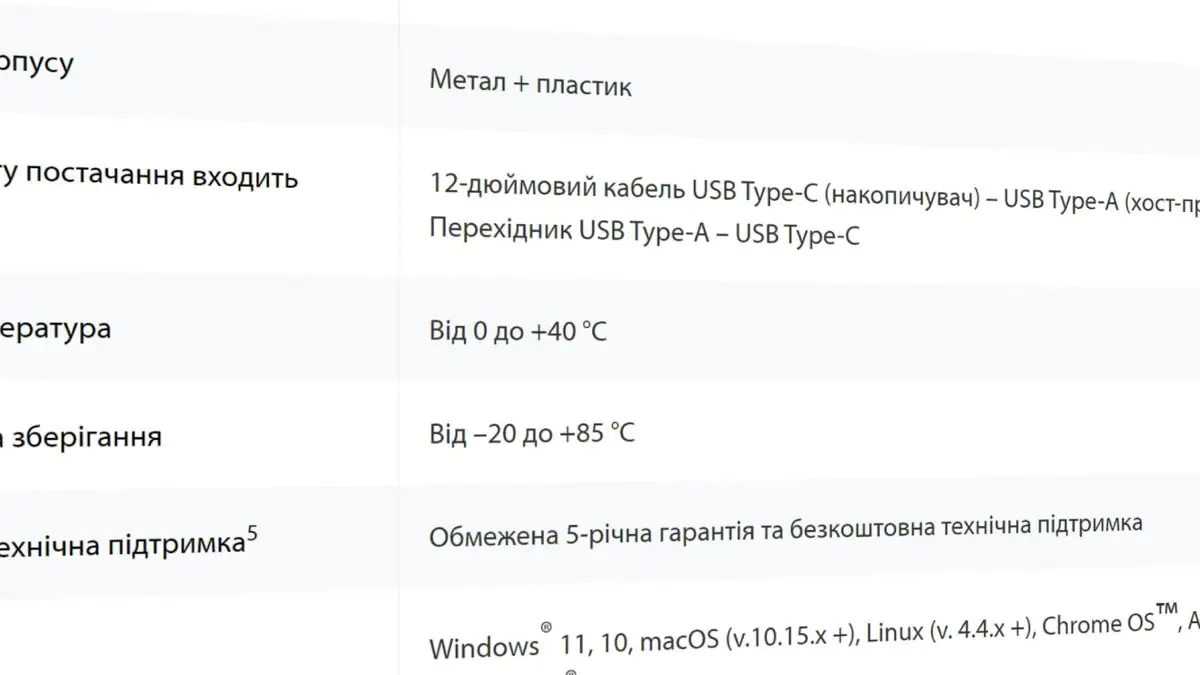© ROOT-NATION.com - Use of content is permitted with a backlink.
It’s always exciting to be at the forefront of technological eras—like witnessing the release of the first multi-core processor or a smartphone with an under-display camera. For me, the Kingston XS1000R 2TB external SSD marks the beginning of the end for external HDDs, or hard drives. While HDDs will certainly remain on the market for a long time, they can no longer compete with the popularity of SSDs. I’ll explain why using the XS1000 as an example.
Technical specifications
- Interface: USB 3.2 Gen 2
- Speed: up to 1050 MB/s
- Memory: NAND 3D
- Dimensions: 69.54×32.58×13.50 mm
- Weight: 28.7 g
- Case material: metal + plastic
- Operating temperature: 0 to 40 °C
- Storage temperature: -20 to 85 °C
- Warranty: 5 years

Video review of Kingston XS1000R 2TB

Market positioning and price
Let’s start with the price. The Kingston XS1000R 2TB costs around $150 or €130. There’s also a 1TB version available. However, if you come across the XS1000 in a 500GB or 4TB capacity, keep in mind that it’s actually the XS2000; I’ll mention that model later.

Let me be clear: any branded 2TB external HDD costs about three times less if you’re just looking for storage capacity. And if you need portability, a 64GB USB flash drive from Kingston currently sells for $5–$7. However, there’s a reason both hard drives and flash drives are losing ground. Spoiler alert: they can’t compete with SSDs.
Package contents
The Kingston XS1000R 2TB package is quite basic—it includes just the SSD itself along with some cables. Specifically, you get a Type-A to Type-C cable and an adapter from Type-C to Type-A.

That is, the main cable is Type-A to Type-C, and its length is at least 20 cm.
External appearance
Visually, the Kingston XS1000R looks so simple yet attractive that there are already knock-offs appearing on AliExpress. It’s essentially just a metal box with a logo and a connector; it’s pocket-sized, convenient, and comes in black and red. These correspond to the Kingston XS1000R and Kingston XS1000 models.

I’d also like to note that the XS1000 series is positioned by the manufacturer, Kingston, as storage for documents and applications. It’s meant for digital libraries and family albums since losing files from an SSD is generally more difficult, and retrieving them is easier. If you need a drive for games, Kingston offers the XS2000 model, which features USB 20 Gbps.

I should also mention that the drive weighs noticeably less than I expected—almost 29 g—because it’s built on a sandwich principle: metal on the top, metal on the bottom, and plastic in the center. The casing can be disassembled, but reassembling it is nearly impossible due to the fragility of the plastic clips. Additionally, there’s a working indicator next to the USB port.

Specifications
Regarding specifications, we don’t have any data, as Kingston does not provide precise details for their external SSDs. What is known is that it uses 3D NAND memory, and since the warranty, although limited, is 5 years, I wouldn’t worry too much about the exact specifications. Moreover, Kingston can change the chips whenever they want—many models support the promised speeds, and no one will notice the difference.

So, the SSD capacity is 2 TB, and the data transfer protocol is USB Type-C 10 Gbps or USB Type-C 3.2. Since 8 Gbit = 1 GB, the protocol just covers the promised speed with a margin. Let me remind you that the manufacturer promises speeds of up to 1 GB/s.
Read also: AMD Ryzen 5 7600 Processor Review: Is It Enough?
Also, IMPORTANT! The first connection of the Kingston XS1000R 2TB should be done with a “cold start.” This means you should connect the drive and simply leave it alone for about one to two hours. This will help activate TRIM. On Windows, there’s nothing else you need to do, but on macOS, you’ll need to enable TRIM support separately in the settings.
Details by USB
There’s a small nuance here. For a long time, I believed that according to USB IF specifications, the USB Type-A connector does NOT support 10 Gbps, with a maximum of 5 Gbps. To check, I immediately pulled out my 20 Gbps Type-C to Type-C cable and conducted the main tests with it. HOWEVER! I was wrong. The included cable supports 10 Gbps even through the adapter.

Was I wrong? I’m not sure. For instance, I have a bunch of 3-meter Type-C cables rated for 100 W that can genuinely charge laptops. What’s the catch? They’re all USB 2.0. First of all, the USB IF specifications don’t even mention USB Type-C under USB 2.0, meaning it shouldn’t exist in nature—but the Chinese made it. Secondly, USB 2.0 officially can transmit a maximum of 2.5 W, not 100 W.

Why do I mention this? If you have a USB Type-A port, it’s likely 5 Gbps. If it’s 10 Gbps, it’s probably a “special proprietary” one, like those from Xiaomi, since you won’t be able to achieve a 120 W charge with a standard Type-A. So, if your Kingston XS1000R is showing around 500 MB/s in tests, it’s likely due to the cable. Therefore, look for a Type-C cable rated for 10 Gbps; it will be much easier to find.
Test results
After initialization in the system as an exFAT disk, the Kingston XS1000R 2TB provides the user with 1810 GB of free space. Speed tests revealed, firstly, a very stable promised speed consistently.

Secondly, there is a certain amount of write caching—between 20% and 10% of the total capacity for sequential and random writes, respectively.
The drive’s casing heated up to 71 degrees during an unrealistic stress test for random speed testing. However, during sequential testing, the temperature peaked at a maximum of 44°C. In the official specifications, the maximum operating temperature is stated as +40°C.

This is one of the hints recommending that the Kingston XS1000R 2TB should not be used for tasks you would typically assign to a regular SSD—such as launching games, for example. For that, Kingston offers the XS2000, which I’ll be happy to test later.
Conclusions
Can the Kingston XS1000R 2TB replace your flash drive? Absolutely, it can. It’s specifically positioned for that purpose. You can easily watch movies from it, store documents, applications, and more. It’s lightweight, compact, and convenient. Whether you need 2 TB is up to you to decide. But in any case, yes, I recommend it.
Read also:
- Review of PC with the Gigabyte Radeon RX 7900 GRE Gaming OC 16G: Can a Powerful Graphics Card Compensate for a Weak Processor?
- Cougar Duoface Pro RGB Computer Case Review
- be quiet! Dark Rock 5 Cooler Review: Most Modest Flagship





